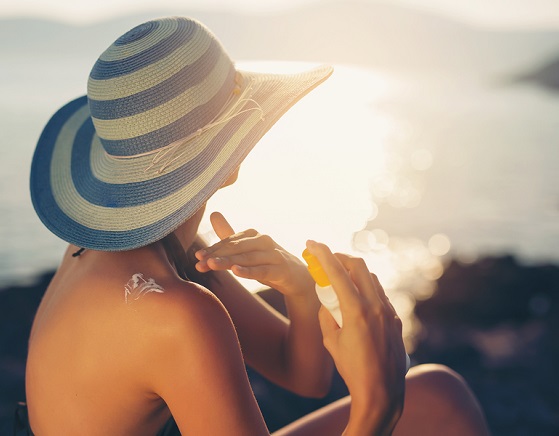Face in the Mirror: My Skin Cancer Experience.

It was a small red dot on the side of my nose. I covered it with cream and concealer. At age 60, I was not only fighting crow’s feet but those willful zits that caused scars.
It slowly shrank, not with a whimper of soap and water but a blast of the strongest percentage of benzoyl peroxide I could use without a prescription.
Months passed, and the little bugger persisted to taunt me in the mirror. At first, the remainder resembled a kind of crustacean, a bit of a barnacle which lightly bled.
Like the snow, I assumed it would evaporate over winter and spring would find me ready to wear short sleeves and my regular sunscreen. But the leftover didn’t leave. In fact, time, sung so optimistically by the Stones, was not on my side. Because underneath that seemingly harmless spot was something a lot more sinister.
Most people don’t think all that much about their skin. If it acts up, they buy an over-the-counter cure. The winter caused my skin to itch. I was forced to take a trip to the dermatologist. All was well except for my incessant scratching. Then he noticed that pesky pimple.
“Could be skin cancer,” he said.
No formal introduction, not even an, “Oh, oh, what have we here?” It felt like a matter-of-fact slap in my face with a biopsy kicker.
A slice of skin later he told me I’d have to wait a week for the results. I sat stunned, trying to let the last 10 minutes sink in. How could a simple pimple be cancer?
A week later, I listened to the voicemail telling me to call the nurse for the pathology report. The doctor wasn’t giving me the news so I told myself it was probably nothing. The mind does its denial dance with astounding speed. My simple pimple turned out to be basal-cell carcinoma.
The nurse mentioned something called Mohs surgery. How could a surgery with the same name as one of the Three Stooges be my only option? I decided to seek a second opinion. He confirmed the diagnosis and set up the Mohs surgery. It didn’t feel funny now.
I carefully confessed to close friends. For some strange reason, I felt ashamed. I wasn’t a particularly vain woman, though I liked the occasional you’re pretty compliment. I had hoped to age gracefully with my earned lines and growing grey hair. Now, what would I be facing, quite literally: scars, discoloration, disfigurement?
What had I done to deserve such a fate? I’d never been a sun-worshiper. I’d never used a tanning bed or vacationed in tropical climates. There was no history of it in my family. My only crimes, it seemed, was that I was growing older, possessed a deadly combo of fair skin, auburn hair, and a childhood that never heard of sunblock.
The day of my surgery, I’d been well-versed via the internet on what they intended to do. It seemed unlikely I would come out of this totally unscathed and unscarred physically or mentally. I’d already had the nightmare involving villagers with torches running me out of town.
I entered a room filled with soothing music and a big screen depicting scenes of Mother Nature’s finest. I think I must have used up all of my fear cards beforehand because I lay there like a lump. They numbed my nose. I would be wide awake, a captive audience, for this dramatic stage production. The doctor drew a map of where he would cut.
It wouldn’t be a simple one, two, scrape and smooth, as a few of my friends had advised. They cut a little, then cut a little more, until all the cancer cells were gone.
I guess I should have been relieved at this point. But, I felt as numb as my poor, put-upon nose. Now came the patching back together so some semblance of what once was might be again. They used a skin flap. My hole was too big to heal on its own, nor could it be simply stitched up and sent home. The flap required the use of adjacent skin which would be sewn together to close the wound.
Well-meaning friends, who’d had similar basal-cell scares, had made the surgery sound like it would be a straightforward procedure: little scrape, a little stitch, no sweat. I’d gone in thinking it would be a cinch, but came out realizing what’s on the surface doesn’t necessarily reflect what’s underneath. This was no cinch, this was a long line of stitches and swelling and a bandage so big it covered my entire nose.
I had to wait 48 hours to remove the bulky pressure bandage they used to reduce swelling. I could barely breathe. I slept sitting up that night and the next.
The day I took off the bulky bandage was my day of reckoning. I peeled it back slowly, taking in the parts of my nose still untouched by cancer. At least half of it was still me. I knew there would be stitches, but there were so many and my nose seemed uneven.
My first thought was: I can’t live with this. There was a big dark patch of stitchery where my right nostril should be.
The doc assured me all would eventually mold into its proper place. If not, there could be some refinements done.
While still bandaged, I decided to go out in public. I realized I had no reason to feel ashamed. It’s an incredibly common cancer. A few folks asked me what happened. I told them I was in a bar fight and they should see the other guy.
It’s a rough experience for anybody. Though the physical scarring would decrease, the mental and emotional scarring also needed some attention.
We, who have gone through skin cancer surgery, remain in fear of the next odd bump or pimple. We slather on the sunblock and wear wide-brimmed hats and hope it helps. Unfortunately, a skin cancer survivor risks growing more.
Mohs, despite my Stooges reference, is considered the gold standard for skin cancer. It cuts out the carcinoma, conserves healthy skin, and has a 97% cure rate.
In this country, we’re subject to insurance coverage issues and the social stigma of poverty. Cancer patients who are under-covered or uncovered have to fight for their lives while fighting to keep from falling apart mentally and financially. Imagine you’ve been told, “Congratulations, you’re cured.” But in the process, you’ve gone bankrupt.
It’s not a pretty picture: a surgery that could save, but the disease tends to steal a person’s control over their own body while their country’s health care system endeavors to steal away their dignity and quality of life.
I’m old enough not to care quite so much about my facial features. It’s a sad fact that older women are often invisible in our youth-obsessed culture. That works for me in this situation. At my age, I’m beginning to appreciate the real me, which has more to do with maintaining faith in myself and less to do with maintaining the face in the mirror.
***

Wendy Schmidt has been writing short stories, essays, poetry, and producing collage art for the last 10 years. Her pieces have been published in Verse Wisconsin, Chicago Literati, City Lake Poets, Literary Hatchet, Moon Magazine, Rebelle Society, and a variety of anthologies.

